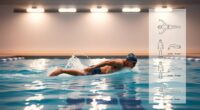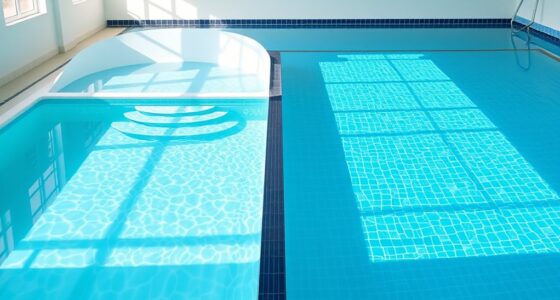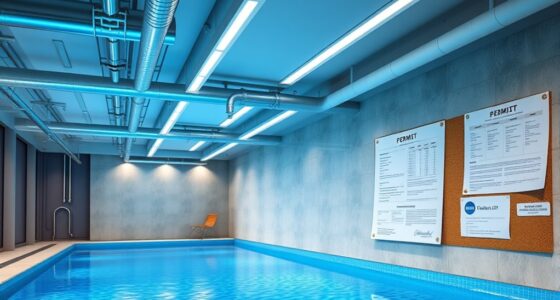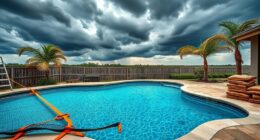Your Endless Pool’s power draw depends on its size, equipment, and how often you use it, typically ranging from 1.5 to 3.5 kW during operation. To cut energy costs, you can lower the temperature, use energy-efficient pumps, and keep equipment maintained. Installing covers and smart timers also helps. Want to find out exactly how much power your pool uses and the best ways to save? Keep exploring to learn more tips and tricks.
Key Takeaways
- Endless Pool energy consumption varies by model, typically between 1.5 to 3.5 kW during operation.
- Main energy users are the pump (often running continuously or on schedule) and heater.
- Using energy-efficient pumps, LED lighting, and programmable timers can significantly reduce power draw.
- Regular maintenance, such as cleaning filters and checking for leaks, improves efficiency and lowers costs.
- Monitoring power use with a plug-in meter helps identify savings opportunities and optimize energy consumption.
Understanding Your Endless Pool’s Power Consumption

Understanding how much energy your Endless Pool uses is essential for managing your electricity bills and ensuring efficient operation. The pool’s power consumption depends on factors like size, heater use, and the speed of the current generator. Typically, the pump and heater are the main energy consumers. Pumps run continuously or on a schedule, consuming varying amounts of electricity based on their settings. Heaters, which maintain water temperature, also add to your energy use, especially during colder months. Monitoring your pool’s energy use helps you identify when it’s operating efficiently and when it might be consuming excess power. Being aware of these components allows you to optimize usage and avoid unnecessary expenses. This understanding is the first step toward controlling your pool’s energy footprint.
Key Factors That Influence Energy Usage
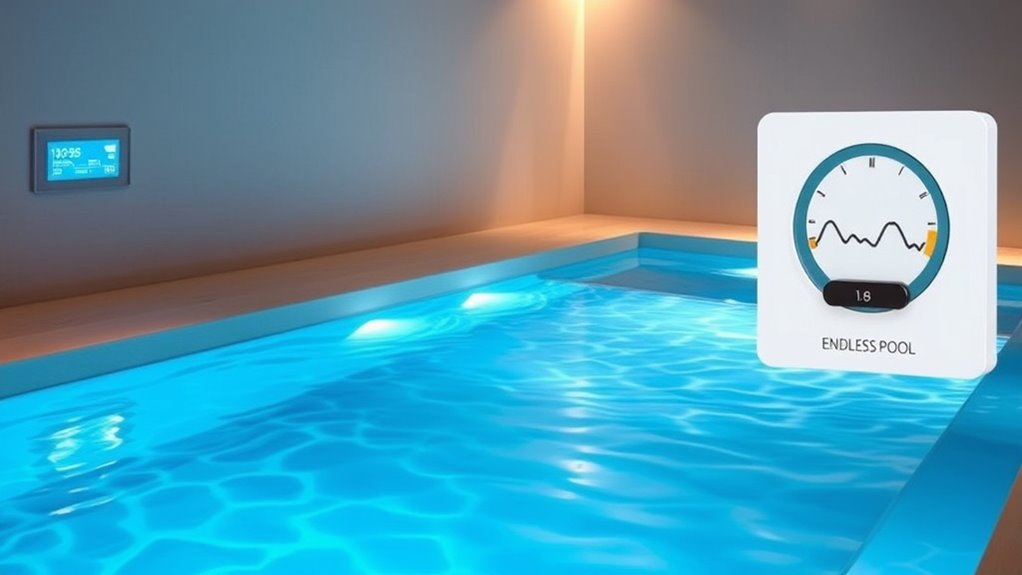
Several key factors directly impact how much energy your Endless Pool consumes. First, the pool’s size and water volume matter; larger pools require more energy to heat and circulate. The temperature you set also plays a role—higher temperatures increase energy use. The efficiency of your filtration and circulation systems affects overall consumption, with newer, energy-efficient models reducing power needs. Usage patterns are critical too: running the pool more frequently or for longer periods increases energy use. Additionally, environmental conditions like ambient temperature influence heating costs—colder surroundings demand more energy to maintain desired water warmth. The age and maintenance of your equipment can impact efficiency; well-maintained components operate more effectively, helping you save on energy. Moreover, understanding narcissistic behavior can help you recognize manipulative tendencies that may be present in household members, potentially affecting your mental well-being and decision-making.
Typical Electricity Costs for Operating an Endless Pool

The typical electricity costs for operating an Endless Pool can vary widely depending on factors like pool size, temperature settings, and usage patterns. On average, you might spend between $20 and $60 per month on electricity. Smaller models with lower power requirements tend to cost less, especially if you keep the water at moderate temperatures. Running the pump and heater frequently increases costs, while occasional use or lower temperatures help cut expenses. Your local electricity rates also play a role—higher rates mean higher bills. To estimate your costs accurately, consider your pool’s wattage and how often you use it. Keeping your settings optimized and limiting usage during peak times can help you save money over time. Additionally, understanding the contrast ratio of your equipment can help you manage energy consumption more effectively.
How to Measure Your Pool’s Power Draw
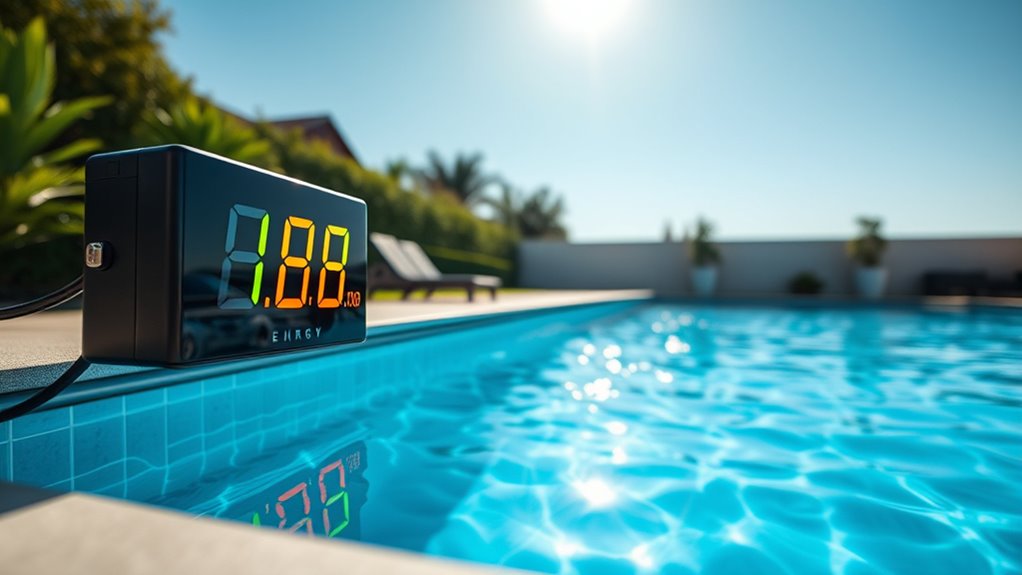
To accurately measure your pool’s power draw, you’ll need a power meter that plugs directly into your electrical outlet and connects to your pool equipment. First, unplug your pump or heater if they’re running. Then, plug the power meter into the outlet, and connect your equipment’s power cord to the meter. Turn on your pool equipment as usual. The meter will display real-time energy consumption in watts or kilowatt-hours. Note the reading after a set period, like 15 or 30 minutes, to get an average. Keep in mind that power draw can vary based on equipment settings and usage. Regular measurements help you understand your pool’s energy needs and identify ways to optimize efficiency. Understanding your equipment’s net worth can also help you gauge the overall cost-effectiveness of your pool setup.
Practical Tips to Reduce Energy Consumption
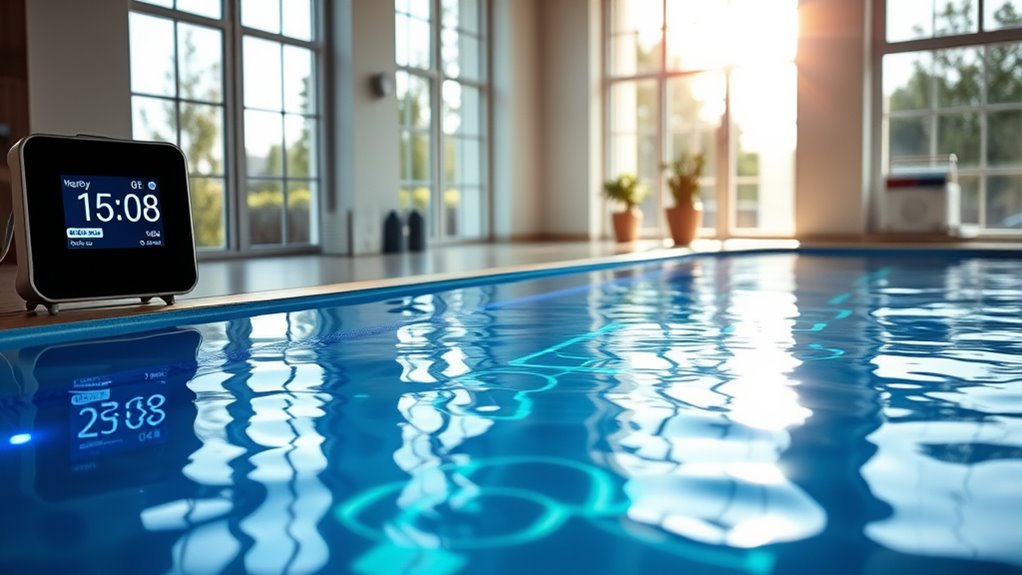
You can cut down on energy use by adjusting your pool settings for efficiency and avoiding unnecessary features. Regular maintenance keeps your equipment running smoothly and prevents waste. Additionally, upgrading to energy-efficient pumps and heaters makes a significant difference in reducing your overall power consumption.
Optimize Pool Settings
Adjusting your pool’s settings can considerably cut energy costs without sacrificing comfort. Start by setting the heater to a lower, consistent temperature—around 78-80°F—reducing energy use while keeping the water comfortable. Use the timer feature to operate the pump and heater only during peak usage times, avoiding continuous operation. Enable the pool’s energy-saving mode if available, which optimizes filtration cycles and pump speed. Keep the filter running efficiently by choosing a lower pump speed, as this still maintains water clarity but consumes less power. Additionally, turn off or set the pool to standby mode when not in use for extended periods. Small adjustments like these can substantially lower your energy bill while ensuring your pool remains inviting and functional. Incorporating energy-efficient equipment can further reduce power consumption and enhance overall savings.
Regular Maintenance Checks
Regular maintenance checks are essential for keeping your pool’s energy consumption in check. Regularly inspecting your endless pool helps identify issues like clogged filters, leaks, or worn-out parts that can cause inefficiencies. Clean or replace filters as needed to ensure proper water flow and prevent the pump from working harder than necessary. Check the pump and heater for leaks or corrosion, which can increase energy use. Keep the water level consistent; too low or too high can strain the system. Additionally, monitor the condition of seals and gaskets, replacing any that show signs of wear. Staying proactive with maintenance reduces unnecessary strain on your equipment, helping your pool operate efficiently and lowering overall energy costs. Incorporating sound recording techniques and equipment maintenance can further optimize the system’s performance and longevity.
Use Energy-Efficient Equipment
Are there simple ways to cut down your pool’s energy use? Yes, choosing energy-efficient equipment makes a big difference. Switch to a variable-speed pump instead of a single-speed one; it runs only as fast as needed, saving power. Use LED lighting instead of traditional bulbs, which consume less energy and last longer. Invest in a high-efficiency heater designed for pool use; these models heat faster and use less electricity. Consider installing a smart controller or timer to operate equipment only when necessary, avoiding unnecessary running time. By upgrading to energy-efficient equipment, you reduce your pool’s power draw, lower your energy bills, and extend the lifespan of your pool components. Additionally, selecting energy-efficient technology ensures your pool operates sustainably and reduces environmental impact. It’s a smart, effective step toward a more sustainable and cost-effective Endless Pool experience.
Comparing Energy Efficiency of Different Models
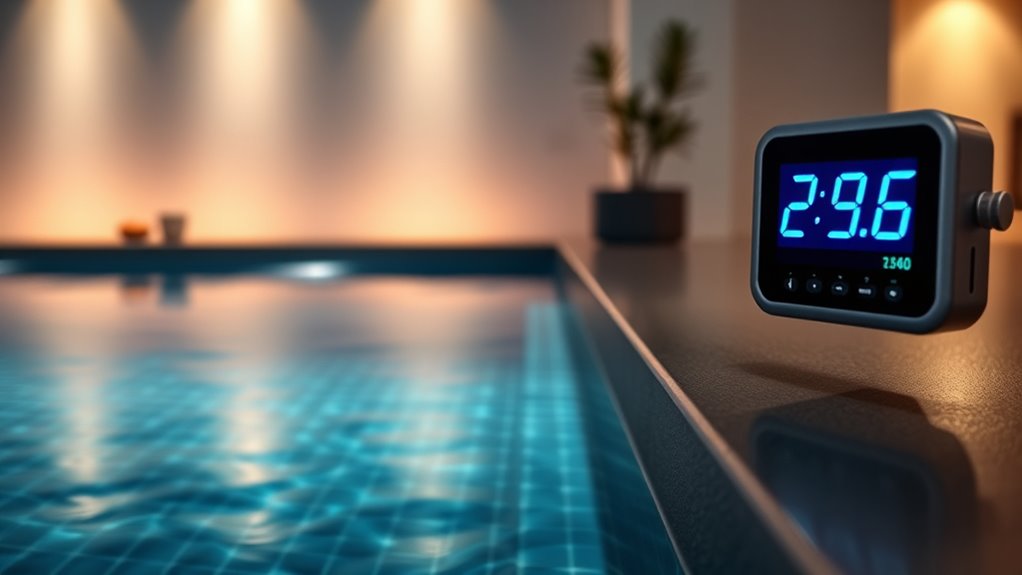
When comparing models, start by looking at their power consumption to see which one uses less energy daily. Consider the energy-saving features, like insulation or variable speed pumps, that can cut costs over time. Also, match the size and usage needs to guarantee you’re choosing a model that fits your space and activity level efficiently. Incorporating wall organization systems can help optimize your space and reduce clutter, indirectly supporting a more efficient and enjoyable home environment.
Model Power Consumption
Different Endless Pool models vary profoundly in their power consumption, making it essential to compare their energy efficiency carefully. Some models use as little as 1.5 kilowatts during operation, while others may draw up to 3.5 kilowatts or more. Factors like size, motor strength, and water features influence overall energy use. Smaller models with streamlined designs typically consume less power, while larger, feature-rich units tend to require more. When choosing a model, consider not only the initial cost but also ongoing energy expenses. By evaluating the power ratings listed in product specifications, you can estimate how much energy each model consumes over time. This comparison helps you select a model that balances performance with efficiency, saving you money in the long run. Additionally, implementing space and organization strategies in your setup can help optimize the placement and integration of your pool system to further enhance energy savings.
Energy Saving Features
Many models now feature energy-saving technologies designed to reduce power consumption without sacrificing performance. These features include variable-speed pumps, programmable timers, and insulated covers that help retain heat. By adjusting pump speeds based on usage, you use less energy during less intensive swimming sessions. Programmable timers allow you to schedule operation times, preventing unnecessary run times when the pool isn’t in use. Insulated covers trap heat, reducing the workload on the heater and lowering energy bills. Some models also incorporate energy-efficient motors and advanced control systems that optimize power use. Implementing energy-efficient components can significantly enhance overall savings and performance. Comparing these features across different models helps you find an option that balances performance with lower energy costs, making your pool more eco-friendly and economical to operate.
Size and Usage Needs
Choosing the right size and understanding your pool’s usage needs are crucial for maximizing energy efficiency. If you opt for a pool too large for your routine, you’ll waste energy maintaining unnecessary water volume and running equipment longer than needed. Conversely, a pool that’s too small might not meet your workout or relaxation goals, leading to overuse of the pump or heater. Consider how often you’ll use the pool and for what purposes. For light or occasional use, a smaller model with efficient features may be enough. For regular, intensive workouts, a larger, more powerful model might be necessary—but look for energy-efficient motors and insulation. Matching your pool size to your actual needs ensures you avoid unnecessary energy waste while enjoying peak performance. Additionally, vibrational alignment with your goals can help you choose the most suitable model that supports your wellness and energy efficiency objectives.
Frequently Asked Questions
Are There Eco-Friendly Alternatives to Traditional Endless Pool Models?
Yes, eco-friendly alternatives to traditional endless pools exist. You can opt for solar-powered models that harness sunlight to run the pump and heater, substantially reducing energy consumption. Additionally, look for pools made with sustainable materials or those with energy-efficient features like better insulation and variable-speed pumps. These options help lower your carbon footprint while providing the same relaxing, convenient swimming experience.
How Does Ambient Temperature Affect Energy Consumption?
Sure, crank up the ambient temperature, and suddenly your endless pool becomes a luxury hot tub, slurping less energy. Cooler air, on the other hand, makes your heater work overtime, turning your energy savings into a costly joke. So, if you want to cut energy use, keep your pool in a cozy environment—because nothing says “smart savings” like fighting the cold, one heated splash at a time.
Can Solar Panels Power an Endless Pool Effectively?
Yes, solar panels can power an Endless Pool effectively if you size your system correctly. You’ll need enough panels to generate the pool’s energy needs, especially during sunny months. Consider adding a battery storage system to guarantee continuous use during cloudy days or at night. Proper planning, including energy-efficient equipment and possibly a backup power source, helps maximize your solar investment and keep your pool running smoothly year-round.
What Maintenance Practices Can Optimize Energy Efficiency?
Think of your pool’s energy efficiency as a well-tuned orchestra; every part must play in harmony. Regularly clean filters and check for leaks to prevent unnecessary energy waste. Use a cover when not swimming to retain heat and reduce pump work. Schedule maintenance for the heater and pump to make certain they’re running smoothly. These practices keep your pool running efficiently, saving energy and lowering costs.
How Does Usage Frequency Impact Overall Energy Costs?
If you use your Endless Pool more often, your energy costs will increase because the pump and heater run longer. To save money, consider limiting your sessions or scheduling them during off-peak hours. Regular maintenance also helps guarantee efficient operation. By managing your usage frequency and maintaining your equipment, you can reduce overall energy expenses while still enjoying your pool regularly.
Conclusion
By understanding your Endless Pool’s power draw and implementing simple energy-saving tips, you can enjoy your swim without breaking the bank. Regularly measuring your energy use helps confirm these savings, making it easier to spot opportunities for efficiency. While some believe turning off the heater saves money, it may affect your comfort and enjoyment. Ultimately, staying informed about your pool’s energy habits guarantees you maximize fun while keeping costs manageable.


